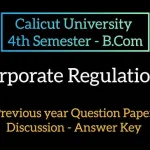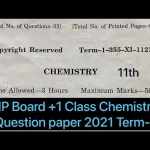The 12th Chemistry public question paper for 2022 provides a diverse range of questions that assess students’ understanding of key concepts in Chemistry. This set includes theoretical, numerical, and application-based questions, designed to evaluate knowledge and problem-solving skills. Below are important questions and answers covering all types of topics from the syllabus.
Important Questions and Answers
Question: What is the octet rule in chemical bonding?
Answer: The octet rule states that atoms tend to gain, lose, or share electrons to attain a stable configuration of eight valence electrons in their outer shell.
Question: Define hybridization and its significance.
Answer: Hybridization is the mixing of atomic orbitals to form new hybrid orbitals, which have equivalent energy and shape. It explains the geometry of molecular structures.
Question: What is the difference between sigma and pi bonds?
Answer: A sigma bond is formed by the head-on overlap of orbitals, while a pi bond is formed by the sideways overlap of orbitals. Sigma bonds are stronger than pi bonds.
Question: Explain the concept of ionization energy.
Answer: Ionization energy is the energy required to remove an electron from an atom in its gaseous state to form a positive ion.
Question: What is Hess’s Law of constant heat summation?
Answer: Hess’s Law states that the total enthalpy change in a reaction is the same, regardless of the pathway taken, provided the initial and final conditions are the same.
Question: How is the rate of a chemical reaction defined?
Answer: The rate of a chemical reaction is the change in concentration of a reactant or product per unit time.
Question: What is a buffer solution?
Answer: A buffer solution is one that resists changes in pH when small amounts of an acid or base are added to it.
Question: Define electrochemical cell.
Answer: An electrochemical cell is a device that converts chemical energy into electrical energy through redox reactions.
Question: What is the importance of the equilibrium constant?
Answer: The equilibrium constant provides the ratio of the concentration of products to reactants at equilibrium and indicates the extent of a reaction.
Question: What is the difference between empirical and molecular formulas?
Answer: The empirical formula represents the simplest ratio of atoms in a compound, while the molecular formula represents the actual number of atoms of each element.
Question: Define the term “activation energy.”
Answer: Activation energy is the minimum energy required for a chemical reaction to occur.
Question: What is the role of a catalyst in a reaction?
Answer: A catalyst increases the rate of a chemical reaction by lowering the activation energy without being consumed in the reaction.
Question: Explain Le Chatelier’s Principle.
Answer: Le Chatelier’s Principle states that if a system at equilibrium is disturbed, the system will adjust to minimize the disturbance and restore equilibrium.
Question: What is an alloy? Give an example.
Answer: An alloy is a homogeneous mixture of two or more metals, or a metal and a non-metal. Example: Brass (copper and zinc).
Question: What is the difference between crystalline and amorphous solids?
Answer: Crystalline solids have a regular, repeating arrangement of atoms, while amorphous solids lack a defined structure.
Question: Define molarity and normality.
Answer: Molarity is the number of moles of solute per liter of solution. Normality is the number of gram equivalents of solute per liter of solution.
Question: What are isotopes? Provide an example.
Answer: Isotopes are atoms of the same element with the same atomic number but different mass numbers. Example: Carbon-12 and Carbon-14.
Question: Explain the term “colligative properties.”
Answer: Colligative properties are properties of solutions that depend on the number of solute particles, not their identity, such as boiling point elevation and freezing point depression.
Question: What is the greenhouse effect?
Answer: The greenhouse effect is the trapping of heat in the Earth’s atmosphere due to the presence of greenhouse gases like carbon dioxide and methane.
Question: Explain the significance of the periodic table.
Answer: The periodic table organizes elements based on their properties and atomic structure, enabling prediction of element behavior and trends.
Question: What is a nucleophile and an electrophile?
Answer: A nucleophile is a species that donates an electron pair, while an electrophile is a species that accepts an electron pair.
Question: Define standard electrode potential.
Answer: Standard electrode potential is the potential difference between an electrode and its solution when the system is at standard conditions (1 M, 1 atm, 25°C).
Question: What are halogenated hydrocarbons?
Answer: Halogenated hydrocarbons are organic compounds containing one or more halogen atoms attached to a carbon chain.
Question: Describe the difference between thermoplastics and thermosetting plastics.
Answer: Thermoplastics can be reshaped by heating, while thermosetting plastics cannot be remolded after setting.
Question: What is Raoult’s law?
Answer: Raoult’s law states that the partial vapor pressure of a component in a solution is directly proportional to its mole fraction.
Question: What is the function of antioxidants in food?
Answer: Antioxidants prevent oxidation and spoilage of food by neutralizing free radicals.
Question: What are the types of adsorption?
Answer: Adsorption is of two types: physisorption (physical adsorption) and chemisorption (chemical adsorption).
Question: Explain the term “esterification.”
Answer: Esterification is the reaction of a carboxylic acid with an alcohol to form an ester and water.
Question: What is the difference between a primary and secondary alcohol?
Answer: A primary alcohol has the -OH group attached to a carbon bonded to only one other carbon, while a secondary alcohol is attached to a carbon bonded to two other carbons.
Question: Define corrosion and its prevention.
Answer: Corrosion is the deterioration of metals due to chemical reactions with their environment. Prevention methods include galvanization and coating.
Question: What is a polymer? Provide an example.
Answer: A polymer is a large molecule made of repeating units called monomers. Example: Polyethylene.
Question: Explain the significance of Gibbs free energy.
Answer: Gibbs free energy determines whether a process is spontaneous. A negative value indicates spontaneity.
Question: What are enantiomers?
Answer: Enantiomers are stereoisomers that are non-superimposable mirror images of each other.
Question: Define oxidation and reduction.
Answer: Oxidation is the loss of electrons, while reduction is the gain of electrons.
Question: What are aromatic compounds?
Answer: Aromatic compounds are organic molecules that contain a conjugated ring system and follow Huckel’s rule.
Question: What is saponification?
Answer: Saponification is the hydrolysis of fats or oils with an alkali to form soap and glycerol.
Question: Explain the term “enthalpy.”
Answer: Enthalpy is the heat content of a system at constant pressure.
Question: What are transition elements?
Answer: Transition elements are d-block elements that form compounds with partially filled d-orbitals.
Question: Define the term “alkali metals.”
Answer: Alkali metals are elements in Group 1 of the periodic table and are highly reactive.
The 12th Chemistry public question paper for 2022 encompasses a variety of questions, preparing students for examinations by covering theoretical and practical aspects. With clear explanations, it aids understanding and revision of key Chemistry concepts
Latest Posts
- Step-by-step guide to download and apply for jee mains admit card 202
- Comprehensive 2025 government holidays and recruitment details for job seekers
- JEE Mains Admit Card 2025: Your Step-by-Step Guide to Downloading the Hall Ticket
- Everything You Need to Know About 2025 Government Holidays Recruitment
- Comprehensive Guide to rrb d group recruitment 2025 – Eligibility, Vacancies, and Application
- Detailed guide to nps trust recruitment 2025 vacancies, eligibility and apply process
- Comprehensive guide to hpcl recruitment 2025 notification, vacancies, and application process
- ignou bed admission 2025 complete recruitment guide with eligibility and process
- Comprehensive Guide to Indian Army Agniveer Recruitment 2025 Notification and Jobs
- Everything You Must Know About CBSE Board Exams 2025 Changes & New Rules





